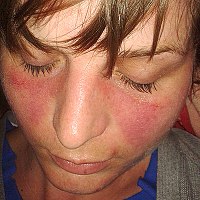
Photo from wikipedia
Antiphospholipid syndrome (APS) is the most frequentacquired thrombophilia. Recent studies estimate that around 10% of individuals with stroke, myocardial infarction, or venous thromboembolism are positive for antiphospholipid antibodies (aPL) [1].… Click to show full abstract
Antiphospholipid syndrome (APS) is the most frequentacquired thrombophilia. Recent studies estimate that around 10% of individuals with stroke, myocardial infarction, or venous thromboembolism are positive for antiphospholipid antibodies (aPL) [1]. The mechanisms by which aPL cause thrombosis are not fully elucidated, however much has been clarified over the last years. A ‘two-hit’ model has been proposed, in which over a procoagulant state induced by aPL, a second hit (other prothrombotic conditions, inflammation, complement activation, etc.) results in clot formation [2]. aPL are capable of creating a thrombogenic environment by a number of mechanisms involving different cell lines as well as clotting factors [2]. One of the most important ones is enhancing the production of tissue factor (TF) by activated monocytes and endothelial cells. Interference with natural regulators such as protein C, antithrombin, and tissue plasminogen activator, increasing production of von Willebrand factor by endothelial cells, and promoting platelet activation have all been demonstrated [2]. Regarding the latter, it is a proven fact that platelets are a main actor in arterial thrombosis in the general population, with solid evidence of a central role also played in the pathogenesis of arterial thrombosis in APS [3]. aPL are able to upregulate plasma levels of active VWF and promote platelet activation [3]. Under high shear forces, antibodies reacting with β2 glycoprotein I (β2GPI) can bind to the surface of stimulated platelets and trigger platelet activation [4], which may lead to the subsequent activation of the endothelium, resulting in fibrin generation and thus making platelet activation a primary mechanism of aPL-mediated arterial thrombosis [5]. With all the above in mind, it would be thus expected that antiaggregant drugs will be protective against arterial thrombotic manifestations of APS. Primary thromboprophylaxis with low-dose aspirin (LDA) in asymptomatic (i.e. without thrombotic events) carriers of aPL has been shown to be effective [6]. Therefore, LDA is generally recommended for such individuals after taking into account a number of personal circumstances. Among these, the repeated positivity for lupus anticoagulant (LA), particularly with the concomitant presence of anticardiolipin (aCL) and anti-β2GPI antibodies (the so-called triple positive patients), the diagnosis of APS secondary to systemic lupus erythematosus, and/or presenting additional cardiovascular risk factors, particularly smoking [7], are considered high-risk thrombotic factors and thus require a more proactive approach [8]. After the empirical observation that immunosuppression did not change the course of the disease, several antithrombotic regimens, mainly LDA and vitamin K (VK) inhibitors at different intensities of anticoagulation, were tried in patients with APS and thrombosis. The observational study by the group of St. Thomas’ Hospital offered the first data in a sizable number of 147 patients (46% with arterial events) distributed in several groups: no therapy, LDA, warfarin at regular intensity (target INR < 3.0), and warfarin at high intensity (INR > 3), both latter groups with or without associated LDA [9] The final conclusions of the study were that the risk of recurrences in untreated patients was unacceptably high and that high-intensity warfarin was the most effective regime, with or without LDA. It is noteworthy that the recurrence rate in the 17 patients treated with combined anticoagulantantiplatelet therapy was zero. Unfortunately, there was no sub-analysis of patients with arterial events. This study paved the way for the general use of highintensity warfarin in the secondary thromboprophylaxis, in general, of APS, at least until the publication of two clinical trials, in 2003 [10] and 2005 [11], both showing no differences between standard and high-intensity anticoagulation, although both studies had the very relevant limitation of the low numbers of patients with arterial disease. Within the next decade, easy agreement was reached for the secondary thromboprophylaxis of venous thromboembolic disease in international consensus in 2011 [12] and 2019 [8], since VK inhibitors given at a target INR 2.0–3.0, like in the general population, are effective in the vast majority of patients with APS. Secondary thromboprophylaxis of arterial disease was, however, a fully different story. A systematic review published in 2007 showed the higher risk of recurrences of patients with arterial thrombosis treated with standard intensity anticoagulation, frequently in the same vascular bed [13]. In the 2011
Journal Title: Expert Review of Clinical Immunology
Year Published: 2022
Link to full text (if available)
Share on Social Media: Sign Up to like & get
recommendations!